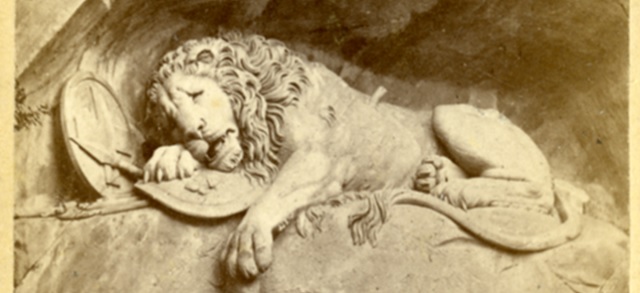
Monuments Class Projects
Architect/Sculptor of Monument
Harriet G. Hosmer
Preview

Identifier
16a
Medium
Photograph, carte-de-viste
Keywords
Harriet Hosmer, Hosmer, Harriet, Sculpture, Monument, Freedmen, Freedman, Freedman’s Monument, Reconstruction, Abraham Lincoln, Lincoln’s Memorial, President Lincoln, unbuilt, Neoclassical, Emancipation, Lincoln, CVD, Freedmen's Memorial, carte-de-vista, Emancipation Memorial.
Physical Dimensions
H: 100 mm, W: 61 mm
Date of Publication
1865
Name of Monument
Freedman's National Monument (1865)
Date of Creation of Monument
1865
City of Monument
Washington, D.C.
Location within City
The statue selected instead was erected in Lincoln Park in Washington D.C.
State/Province of Monument
District of Columbia
Country of Monument
United States of America
Description
This sculpture was designed as a Neoclassical Monument with a temple frame, including multiple levels and platforms, that encloses a sarcophagus with a effigy representing President Lincoln. The temple is surrounded by figures representing the stages of freedom for the emancipated African Americans and reliefs that depict moments from Lincoln's life as well as represent the idea of President Lincoln as the Savior of the Union as well as the Great Emancipator.
School of Art/Architecture
Neoclassical Architecture
Publisher
Frank Rowell
Digital Date
1-19-2022
Copyright
Original physical carte-de-visite is in the public domain. Digital copy scanned by Rod Library, ©2022 Rod Library, University of Northern Iowa.
Rights Advisory
Original print carte-de-visite card is in the public domain; U.S. and International copyright laws protect this digital object. Commercial use of this digital object is not permitted without prior permission of the copyright holder.
Creative Commons License

This work is licensed under a Creative Commons Attribution-NonCommercial 4.0 International License
File Format
image/jpeg
Additional Files
- Freedmans National Monument Report.pdf (98 kB)
Report




Comments
Background
The model shown in the CVD is a monument designed by Harriet Hosmer (1830-1908). The model was built and photographed in 1865 to represent the full-sized monument that Hosmer planned for the Freedman’s Campaign, an organization of recently emancipated slaves. The Western Sanitary Commission, a private agency that helped sick and wounded soldiers during the Civil War as well as helping freedmen and refugees after the war, was in charge of the Freedman’s Campaign and after a few months, $20,000 had been collected from private donations. This amount would have been enough for a modest bronze statue at the time, however, the Commission had more ambitious ideas for the celebration of Lincoln’s achievement. These ambitions led to Hosmer’s elaborate design which they viewed in Boston (1866) and proclaimed to be a great achievement of art. The design featured a temple frame with various stairs, landings, and platforms leading to the top circular center surrounded by four columns and covered by a small dome roof. In the center of this circular platform is a sarcophagus, or stone tomb, with an effigy representing Lincoln on top. The level below this features four statues, one on each corner, that represent the emancipation journey of African Americans. The first statue depicts an enslaved person ready to be sold, the next one works on a plantation, the third individual guides and assists Union troops, and the last serves as a Union soldier. On the lowest level and outer corners of the monument are statues of kneeling angels. The monument also has reliefs, which depict moments from Lincoln’s life including his birth, career as a lawyer, becoming president, events from the Civil War, and his assassination. The base of the circular platform also has reliefs that include thirty-six female figures each representing a state in the Union. The monument’s architecture and sculpture heavily resemble ancient Greek and Roman architecture making it neoclassical in style. Neoclassical design was popular at the time of the monument's conception, and this style also lends itself to depicting Lincoln as a revered and martyred figure, which he had already become viewed as. All of these figures and symbology would be presented on a sixty-foot-square base of granite, with the monument made of marble, and the figures and reliefs in bronze. However, Hosmer’s design was extremely expensive, estimated to cost around $250,000, and attempts to acquire this amount were unsuccessful. Along with the high expense, the monument was also controversial which provided further difficulty in the Commission's attempts to erect the monument. Hosmer’s monument centered on African Americans as the authors of their own freedom story which was problematic for some conservative white Americans at the time. In the end, the Commission settled on a statue monument by Thomas Ball (1819-1911), who proposed a simpler design that gave prominence to Lincoln but was less favorable with African Americans because of its depiction of a recently emancipated freedman kneeling at Lincoln’s feet.
Recommended List of Resources
Harriet Hosmer’s Letters and Memories (1912)
The Missed Opportunity of the Emancipation Monument (2021)
Emancipation and the Freed in American Sculpture: a Study in Interpretation (1916)
Standing Soldiers, Kneeling Slaves: Race, War, and Monument in Nineteenth-Century America (2018)
Harriet Hosmer A Cultural Biography (2010)
Lincoln in American Memory (1995)
The Art Journal (1868)
Bibliography
Culkin, Kate. Harriet Hosmer: A Cultural Biography. Amherst: University of Massachusetts Press, 2010.
Murray, Henry. “Notes.” In Emancipation and the Freed in American Sculpture: a Study in Interpretation, 193-224. Washington, D.C.: Murray Brothers, 1916.
Peterson, Merrill D. “Shapings in the Postwar Years.” In Lincoln in American Memory, 36-81. Oxford: Oxford University Press, 1995.
Savage, Kirk. “Freedom’s Memorial.” In Standing Soldiers, Kneeling Slaves: Race, War, and Monument in Nineteenth-Century America, 89-128. Princeton: Princeton University, 2018.